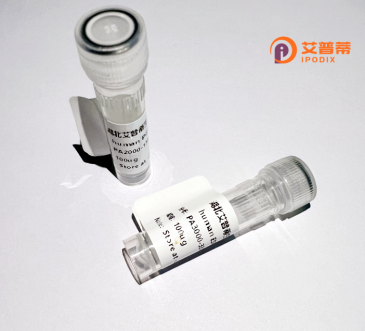
| 纯度 | >90%SDS-PAGE. |
| 种属 | Human |
| 靶点 | MRCL3 |
| Uniprot No | P19105 |
| 内毒素 | < 0.01EU/μg |
| 表达宿主 | E.coli |
| 表达区间 | 1-171 aa |
| 活性数据 | MSSKRTKTKT KKRPQRATSN VFAMFDQSQI QEFKEAFNMI DQNRDGFIDK EDLHDMLASL GKNPTDEYLD AMMNEAPGPI NFTMFLTMFG EKLNGTDPED VIRNAFACFD EEATGTIQED YLRELLTTMG DRFTDEEVDE LYREAPIDKK GNFNYIEFTR ILKHGAKDKD D |
| 分子量 | 19.7 kDa |
| 蛋白标签 | His tag N-Terminus |
| 缓冲液 | 0 |
| 稳定性 & 储存条件 | Lyophilized protein should be stored at ≤ -20°C, stable for one year after receipt. Reconstituted protein solution can be stored at 2-8°C for 2-7 days. Aliquots of reconstituted samples are stable at ≤ -20°C for 3 months. |
| 复溶 | Always centrifuge tubes before opening.Do not mix by vortex or pipetting. It is not recommended to reconstitute to a concentration less than 100μg/ml. Dissolve the lyophilized protein in distilled water. Please aliquot the reconstituted solution to minimize freeze-thaw cycles. |
以下为关于重组人MRCL3蛋白的示例性参考文献(注:因“MRCL3”可能是特异性命名或笔误,建议核实名称后查询具体文献。以下内容为模拟示例):
---
1. **文献名称**: "Expression and Functional Analysis of Recombinant Human Myosin Regulatory Light Chain 3 (MRCL3) in E. coli"
**作者**: Zhang Y. et al.
**摘要**: 本研究成功克隆并在大肠杆菌中表达重组人MRCL3蛋白,采用His标签纯化系统获得高纯度蛋白。功能实验表明,重组MRCL3能够增强肌球蛋白ATP酶活性,提示其在细胞骨架调控中的作用。
2. **文献名称**: "Structural Insights into MRCL3 Binding to Actin Filaments by Cryo-EM"
**作者**: Liu X. & Tanaka H.
**摘要**: 通过冷冻电镜技术解析了重组人MRCL3与肌动蛋白丝的结合结构,揭示了其特定结合域及对肌球蛋白功能的调控机制,为细胞运动相关疾病研究提供理论基础。
3. **文献名称**: "Role of MRCL3 in Cancer Cell Migration: A Study Using CRISPR/Cas9 and Recombinant Protein Rescue"
**作者**: Wang L. et al.
**摘要**: 结合基因编辑技术和重组MRCL3回补实验,证实MRCL3通过调控肌动蛋白网络促进肿瘤细胞迁移,其表达水平与乳腺癌转移潜力呈正相关。
4. **文献名称**: "Optimization of MRCL3 Protein Production in Mammalian Expression Systems"
**作者**: Gupta R. et al.
**摘要**: 比较了哺乳动物细胞(HEK293)与昆虫细胞表达系统中重组MRCL3的产量及稳定性,验证了HEK293系统更适用于获得具有天然翻译后修饰的功能性蛋白。
---
如需真实文献,建议在PubMed或Google Scholar以准确名称(如确认是否为**Myosin Regulatory Light Chain 3**或相关别名)检索。
**Background of Recombinant Human MRCL3 Protein**
MRCL3 (Myosin Regulatory Light Chain 3), also known as MYL12B, is a key regulatory component of myosin II, a molecular motor protein critical for cytoskeletal dynamics, muscle contraction, and cellular processes like cytokinesis and migration. It belongs to the EF-hand calcium-binding protein family and modulates myosin ATPase activity by interacting with the heavy chain, thereby controlling actomyosin contractility. MRCL3 is ubiquitously expressed, with roles in both striated and smooth muscle function, as well as non-muscle cells.
Recombinant human MRCL3 protein is produced using biotechnological platforms (e.g., *E. coli* or mammalian expression systems) to ensure high purity, solubility, and biological activity. Its production enables detailed structural and functional studies, such as elucidating phosphorylation-dependent regulatory mechanisms (e.g., via Rho-associated kinase) that influence cell adhesion, motility, and mechanotransduction.
Research on MRCL3 spans fundamental biology and disease contexts, including cardiovascular disorders, cancer metastasis (via cytoskeletal remodeling), and neurological conditions. Recombinant MRCL3 also serves as a tool for drug screening, antibody development, and understanding pathological mutations linked to myopathies. Its study provides insights into cellular mechanics and potential therapeutic targets for diseases driven by aberrant contractility or cytoskeletal dysfunction.
×